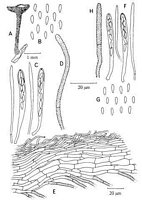|
 Lachnum brevipilosum Lachnum brevipilosum
SynonymsDasyscypha virginea
Lachnum curtipilum
Dasyscypha brevipila
BiostatusPresent in region - Indigenous. Non endemic
Images (click to enlarge)
Caption: Figure 108. Lachnum curtipilum. A-E. P.D.D. 19051. A. Apothecium.B. Ascospores. C. Asci and paraphyses. D. Hair. E. Ectal excipulum on receptacle. F-H. R.W.G. Dennis 30.xii.1967. F. Asci and paraphyses. G. Ascospores. H. Hair. |
Article: Dennis, R.W.G. (1961). Some inoperculate Discomycetes from New Zealand. Kew Bulletin 15(2): 293-320.
Description: Hairs obtuse, thinwalled, granulate, up to 50 x 3 µ, asci
45-50 x 4 µ, ascospores 6-8 x 1-1.75 µ, paraphyses lanceolate, 3 µ wide.
Notes: The apothecia are old and discoloured with rather short hairs but obviously belong to some
member of the D. virgineus complex.
Article: Spooner, B.M. (1987). Helotiales of Australasia: Geoglossaceae, Orbiliaceae, Sclerotiniaceae, Hyaloscyphaceae. Bibliotheca Mycologica 116: 711 p.
Description: APOTHECIA 1.5-3.0 mm high, 1-2 mm diam., long-stipitate, usually densely gregarious,
clustered but not caespitose, superficial. DISC concave, pale orange-brown, smooth,
obscured by the inrolled margin when dry. RECEPTACLE shallow cupulate, concolorous,
rather sparsely clothed with hairs, often irregular or lobed at the margin, incurved on 2 or 3
sides when dry. STIPE central, cylindric, or slightly tapered, often slightly flared at the base,
slender and often curved or flexuous, up to 2 mm high, 150-200 µm diam., similarly clothed
with hairs. HAIRS drying pale buff, whitish when rehydrated, cylindric, obtuse, often curved
or flexuous, thin-walled, septate, granulate throughout, 60-90 x 3.0-3.5(-4.0) µm. ASCI 50-56 x 4.0-4.5 µm, 8-spored, narrowly cylindric-clavate, tapered at the base, apex conical, the
pore blue in Melzer's reagent. ASCOSPORES 5.5-8.0 x 1.5-2.0, mean 6.5 (SD 0.6) x 1.7 (SD
0.1) µm, hyaline, clavate-ellipsoid, often inequilateral, rounded at the ends, non-septate,
irregularly biseriate. PARAPHYSES narrowly lanceolate, hyaline, septate towards the base,
2.5-3.0(-3.5) µm diam., usually exceeding the asci by <5 µm. SUBHYMENIUM 15-20 µm
thick, composed of closely woven, hyaline hyphae 1.5-2.0 µm diam. MEDULLARY
EXCIPULUM composed in the stipe of vertically arranged hyaline, septate hyphae 2.5-3.0 µm
diam. forming a textura porrecta, becoming interwoven in the centre of the receptacle to form
a compact textura intricate of slightly narrower hyphae 2-0-2.5 µm diam., but remaining
parallel in a layer 25-40 µm thick adjacent to the ectal excipulum in the flanks of the
receptacle. ECTAL EXCIPULUM 25-30 µm thick, composed of hyaline, thin-walled
prismatic cells 15-20(-25) x 4.0-6.5 µm, lying in rows almost parallel to the surface.
Habitat: On many kinds of rotten wood.
Distribution: Europe, North Africa,
New Zealand.
Notes: The description given is based entirely on the New Zealand collection, which had been
previously determined as Dasyscyphus virgineus and reported under this name by Dennis
(1961). It differs from that species in having smaller, more clavate spores, shorter and
narrower paraphyses and fewer, comparatively shorter hairs. The apothecia do not have the
appearance of being densely clothed with hairs and, when rehydrated, often appear virtually
glabrous. A similar appearance is evidently typical of D. brevipila which, according to Le Gal
(1939), has the appearance of a Helotium because of the short, scarcely visible hairs. British
material under this name in K varies with regard to stipe length, but the species typically has a
slender stipe. The published figure of 10-15 mm given for the diameter of the apothecia is, as
noted by Dennis (1949), surely an error, probably by omission of the decimal point, as it was
suggested by Le Gal that the species could be confused macroscopically with D. virginea or
D. nivea. It, therefore, has smaller apothecia than the present collection, which also differs in
having rather longer hairs. The spore shape agrees well with that illustrated by Le Gal, though
the spores of the British Collection examined are slightly smaller.
It is possible that recognition of a variety of D. brevipila may eventually prove justified
but, until further collections are available to confirm the differences noted here, such a
proposal is premature.
Transfer of the epithet 'brevipila' to Lachnum is precluded under Article 64 of the
International Code for Botanical Nomenclature as this would create a later homonym of L.
brevipilum (Hõhnel) Nannfeldt.
|